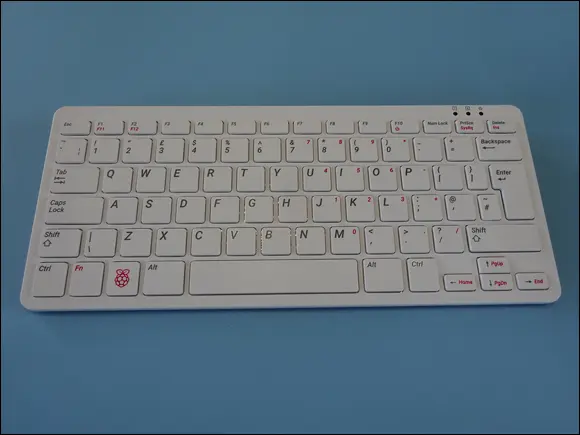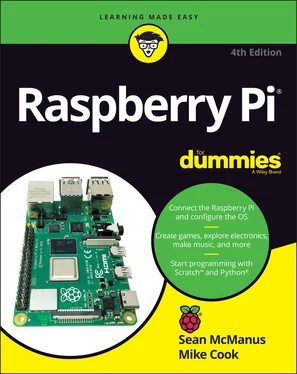The Raspberry Pi 400 (see Figure 1-3) takes even more inspiration from the classic computers of the ’80s by building the Raspberry Pi 4 computer into a computer keyboard. It makes the whole setup much more compact, because you don’t have the separate Pi unit on the table, with a cable going to the keyboard.

FIGURE 1-3:The Raspberry Pi 400 hides the computer inside the keyboard.
There are performance improvements, too. The Raspberry Pi 400 is faster than the Raspberry Pi 4, and it’s designed with passive cooling built in.
The Raspberry Pi 400 is a white keyboard, with all the sockets on the back of it. It features the following:
4GB of memory.
Three external USB ports (one USB 2 port and two higher-speed USB 3 ports). This is fewer than the four ports you get on a Raspberry Pi 4. The fourth port is used to connect the keyboard inside the case.
Built-in Wi-Fi and Bluetooth and a Gigabit Ethernet port for a wired Internet or network connection.
40 GPIO pins, but these are on the back of the case, not on the top surface. You’ll need to use an extension cable or board to use the pins easily and to use add-on boards (see Chapter 21). Although add-on boards can be connected directly, few will work well because their top surface will face away from you.
Support for two monitors at resolutions of up to 4K.
No compatibility with the Raspberry Pi Camera Module. You can use a USB camera, as you can on any Raspberry Pi computer.
There is no audio out socket, so you’ll need to pass audio through your monitor.
The Raspberry Pi 400 costs $70. The Raspberry Pi 400 Personal Computer Kit adds the accessories you’ll need, except for the monitor. The Raspberry Pi 400 is a fantastic value, but it’s more expensive than the bare board. We recommend the Raspberry Pi 400 if your budget will bear it and you plan to use the Raspberry Pi as a desktop computer. For electronics projects, we find the bare board easier to use.
 The official Raspberry Pi keyboard and the Raspberry Pi 400 look the same. If you have both on your desk, put a sticker on one of them; otherwise, you’ll waste time trying to use the wrong one!
The official Raspberry Pi keyboard and the Raspberry Pi 400 look the same. If you have both on your desk, put a sticker on one of them; otherwise, you’ll waste time trying to use the wrong one!
The Model A+ is a cut-down bare-board Raspberry Pi. It’s useful for projects that need lower power consumption — typically battery-based projects. It is suitable for robots and projects in remote locations, where a wired electricity supply isn’t viable and batteries must be used instead.
It features the following:
512MB of memory
One USB 2 port
Built-in Wi-Fi and Bluetooth
A headphones-style audio-out socket
40 GPIO pins
Compatibility with the Raspberry Pi Camera Module
This model has a price of $20. The Model A+ is slightly shorter on the long side than the Raspberry Pi 3, measuring 2½ inches by 2 inches.
The Raspberry Pi Foundation astounded everyone when it gave the Raspberry Pi Zero computer away with the print edition of its magazine The MagPi. We’d seen cover-mounted CDs and even tapes long ago, but never a computer before.
There are three models: Raspberry Pi Zero, Raspberry Pi Zero W (adding wireless networking), and Raspberry Pi Zero WH (adding wireless networking and GPIO pins).
The Raspberry Pi Zero family features the following:
A lightweight, smaller board measuring just 2½ inches by 1 inch.
A single-core 1 GHz processor. This is less powerful than the bigger boards. The Model B and A+ are quad-core, which means there are four processing units inside the chip that can all work at the same time. The quad-core processors run at a higher frequency, too. Here, you get a single core running at a lower frequency.
512MB of memory.
One Micro USB port.
Built-in Wi-Fi and Bluetooth, only on the Raspberry Pi Zero W and Zero WH.
40 GPIO pins, only on the Raspberry Pi Zero WH. On other models, you can solder your own pins.
Compatibility with the Raspberry Pi Camera Module, only on the Raspberry Pi Zero W and Zero WH.
You’ll also need a converter for the Mini HDMI socket, and for the Micro USB socket, so you should expect to spend a bit more than the price of the Pi (and have a bit more complexity in your setup). Billed as the $5 computer, the Raspberry Pi Zero has at times been difficult to get hold of, which is perhaps not surprising given the phenomenal demand for it.
The Raspberry Pi Zero is great for compact electronics projects that don’t need the performance of a Model B or Model A+.
Of course, the older Raspberry Pis are still out there. Recent models usually remain in production while there is demand, and you can buy secondhand versions online from websites such as eBay. Generally speaking, the newer the model, the faster its performance. Memory upgrades have made a difference, as well as the use of more powerful processors, as the Pi has evolved. There are plenty of uses for the Pi that don’t need especially fast performance, though, so you might find that an older Pi is perfect for your project. If you want to support the Raspberry Pi Foundation while buying cheaper, secondhand boards, you can donate to the foundation online.
The older models are described in this list:
Raspberry Pi 1 Model B with 256MB memory: Although it’s called Model B, this was the first Raspberry Pi to be released, in February 2012. The Raspberry Pi Model B features an Ethernet connection for the Internet and two USB ports. It uses an SD card for storage.
Raspberry Pi 1 Model B with 512MB memory: Released in October 2012, the Raspberry Pi Model B had twice the memory capacity. This improved the speed of some software, especially applications that used images heavily.
Raspberry Pi 1 Model A: The Model A, released in February 2013, is a stripped-down version of the Model B. It has just one USB port and doesn’t have an Ethernet port for connecting to the Internet. It has 256MB of memory.
Raspberry Pi 1 Model B+: The Model B+, released in July 2014, has been described by the Raspberry Pi Foundation as “the final evolution of the original Raspberry Pi.” It runs all the same software as the previous versions of the Raspberry Pi, but it has four USB ports, more GPIO pins for connecting electronics projects to the Pi, and lower power consumption and better audio than the Model B. In common with the Model B, it has 512MB of memory. Although all previous versions use SD cards for data storage, the Model B+ introduced the smaller microSD cards, which are now standard on the Raspberry Pi.
Raspberry Pi 2 Model B: Launched in February 2015, this model doubled the memory on the Model B+ to 1GB. It increased performance, compared to the Model B+, while retaining its physical features. Over the years the Pi’s performance has been improved through new software releases as well as updates to the hardware. The Pi 2 represents an immediately noticeable speed-up, compared to the Model B+.
Raspberry Pi 3 Model B: Launched in February 2016, this model has a new 64-bit processor, which means it can handle data in bigger chunks than the previous 32-bit processor. The Raspberry Pi 3 Model B is 50 percent to 60 percent faster than the Raspberry Pi 2 Model B when working in 32-bit mode.
Raspberry Pi 3 Model B+: Launched in March 2018, this model has a faster processor and improved networking speeds. It introduced support for PoE, which enables the Raspberry Pi to be powered through the Ethernet cable. You’ll need to add the Raspberry Pi PoE HAT accessory.
Читать дальше


 The official Raspberry Pi keyboard and the Raspberry Pi 400 look the same. If you have both on your desk, put a sticker on one of them; otherwise, you’ll waste time trying to use the wrong one!
The official Raspberry Pi keyboard and the Raspberry Pi 400 look the same. If you have both on your desk, put a sticker on one of them; otherwise, you’ll waste time trying to use the wrong one!










